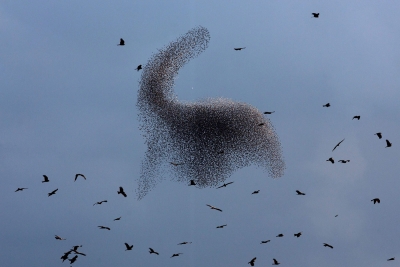
The dark dance in the sky
You may have seen videos of dark and fluid patterns formed by large flocks of birds moving together across the sky. This is called murmuration, and is usually caused by starlings. In fact, the collective noun for starlings is murmuration.
Why do they do it?
One of the most common theories is that the birds find safety in numbers when they migrate (locally or otherwise). When these birds take to the skies in such large numbers, they are bound to tempt raptors (birds of prey) looking for a filling meal. However, no bird obviously wants to be the raptors target! So, “swirling masses create a confusion effect preventing a single individual being targeted”. This is called collective escape. During the escape, they exhibit a variety of patterns and structural complexity through “rapid variation in density and shape of the flock”. Depending on the position and the movement of individuals relative to each other, the types of escape have been classified as ‘flash expansion’, ‘blackening’, ‘wave event’, ‘vacuole’, ‘cordon’ and ‘split. A study says “the specific type of collective escape depends on the collective pattern that precedes it and on the level of threat posed by the raptor. A wave event was most likely to occur when the predator attacked at medium speed”, for instance.
So how do they do it?
The number of starlings in a flock can range from hundreds to thousands. While flying in such a large group – don’t forget all that din – how do the birds communicate to each other what each must do? Now this part is as brilliant as the murmuration itself! Research has established that “individual starlings within large flocks respond to a fixed number of nearest neighbours”. The birds pay attention to their seven closet neighbours for their course of action. A study has established that “when uncertainty in sensing is present, interacting with six or seven neighbors optimizes the balance between group cohesiveness and individual effort”. If that’s not smart team work, what is?
Picture Credit : Google




